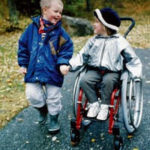 Anat Baniel is a genius at understanding how children develop and how special needs children with mobility challenges can be best supported in achieving the best possible outcomes. I am privileged to have studied with her and use what I learn in working with these children.
Anat Baniel is a genius at understanding how children develop and how special needs children with mobility challenges can be best supported in achieving the best possible outcomes. I am privileged to have studied with her and use what I learn in working with these children.
If you have a special needs child it is likely that you have seen many specialists often with differing opinions about what to do. What is a parent to do? My advice would be to ask as many questions as you have. It might be good to prepare ahead for this. You also might want to connect with parents of other children who have the same condition. Once you have your information, you need to go with your gut in terms of what would be best for your child.
Not being a physician I choose not to address strictly medical concerns in this article.
Having trained as a physical therapist, as well as having connected with parents who have used traditional physical therapy for their children, I would like compare and contrast that with the Anat Baniel Method (sm) for Children. Of course physical therapists vary greatly in how they work and my intention is not to be critical of anyone. What I intend to do is compare the underlying assumptions of the two approaches and how those play out in the care of your child.
Fundamental is a phrase Anat Baniel often uses … “from fixing to connecting”. Rather than approaching a special needs child as someone who is “broken” and therefore requires fixing, as an Anat Baniel Method practitioner I first find my way to connecting with your child just the way he or she is. I was not surprised when one of my little clients came in smiling today and her grandma said, “she likes you”.
My assumption is that your child, though they need some extra help, has a functioning brain and is capable of learning to do more than they currently are doing.
“Neurotypical” infants do lots of random movement. When some of this movement results in a desired outcome such as rolling over to reach a toy or sitting up to get a new view of the world, this is reinforced and mapped in the brain. Hence a child proceeds to achieve “developmental milestones”. When a child’s condition restricts this random movement delays are typical.
In a traditional model as a child falls behind in age-appropriate “milestones” there is often an attempt to simulate to the extent possible the milestone despite the fact that the child has not been through the developmental process to get to that milestone. As Anat likes to say, “if he could, he would, if she could, she would”. Anat Baniel Method practitioners believe that this sort artificial approximation of milestones is not helpful to the development of the child and in fact can be harmful.
When I work with a child using the Anat Baniel Method, once I have connected I look for the missing links in the developmental process. Then I use primarily gentle hands on work and later active movement and language as appropriate to fill in the gaps thus giving your child the opportunity to figure out the next step as a neurotypical child might. Your child develops a powerful learning brain.
Here is what the mom of a little girl I am working with has to say …
“Her head control has improved leaps and bounds. She is starting to use her hands and her muscle tone and arching are improving every day. I would love for this to become the standard of care. I’m so happy to have an amazing ABM practitioner close by!”
If you have or know a child with mobility challenges I’d love to speak with you. Please give me a call at 206-842-4608




